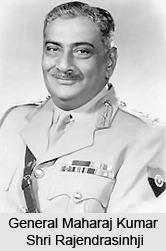Preceded by Office Created Died January 1, 1964 Name Rajendrasinhji Jadeja | Spouse(s) Maya Kunwarba | |
 | ||
Preceded by Field Marshall K M Cariappa Education Royal Military Academy Sandhurst Battles and wars World War II, Indo-Pakistani War of 1947 | ||
Rajendrasinhji jadeja samaghogha
General Maharaj Shri Rajendrasinhji Jadeja, DSO (15 June 1899 – 1 January 1964), also known as Kumar Sri Rajendrasinhji and K.S. Rajendrasinhji, was the first Chief of Army Staff of the Indian army, and the second Indian, after Field Marshal K. M. Cariappa, to become Commander-in-Chief of the Indian Army.
Contents

Personal life
Rajendrasinhji was born on 15 June 1899, at Sarodar in the Kathiawar region of what is now the western Indian state of Gujarat. He was the third son of Devisinhji Jadeja . The family belonged to the ruling Rajput dynasty of Nawanagar State (now Jamnagar), and Devisinhji was the elder brother of K.S. Ranjitsinhji and uncle of K.S.Duleepsinhji, two cricketing luminaries produced by that family. In 1928, Rajendrasingh wed Maya Kunwarba. The couple became the parents of three children. His son, Rajkumar Shri Sukhdevsinhji, married the daughter of the ruler of Masuda in Rajputana, Rajkumari Vijaylakshmi Masuda. His youngest daughter was married to HH the Raja Sahib of the erstwhile princely state of Khairagarh in then Madhya Pradesh (present day Chhattisgarh), she was an MP of the Lok Sabha and a popular leader in her constituency.
Career
Rajendrasinhji attended Rajkumar College, Rajkot, then at Malvern College. Having resolved upon pursuing a military career, he joined the Royal Military College, Sandhurst. In 1921, he was commissioned as a Second lieutenant onto the Unattached List for the Indian Army. He spent a year attached to the 3rd battalion the King's Royal Rifle Corps and then joined the Indian Army and was posted to the 2nd Royal Lancers. As a King's Commissioned Indian Officer, he held various ranks and offices in the British Indian Army and served with distinction during the Second World War.
General Rajendrasinhji became the first Indian to be deputed to serve as Military Attaché to Washington DC in 1945-46.
Second World War
In 1941, Rajendrasinhji was sent to the Mediterranean and Middle East Theatre as a squadron commander of the 2nd Lancers. In April 1941, his brigade, the 3rd Indian Motor Brigade, was surrounded at Mechili by numerically superior Axis forces. Being encircled, the allied forces were left with no option but to hazard a headlong foray through the enemy forces, into the desert. Rajendrasinhji's squadron took the rearguard position during this operation. While the vanguard suffered much loss of life by a German tank attack, Ranjitsinhji's squadron was not seriously impacted. He led his squadron in a charge through the enemy ranks, and they gained respite in the safety of some nearby hills. The squadron essayed further action on the enemy forces after nightfall and achieved considerable success; indeed, it returned to base with sixty prisoners of war. For his courageous leadership and determined action, Rajendrasinhji was awarded the Distinguished Service Order (DSO) in 1941. He was the first Indian to be honoured with this decoration during the Second World War.
In India
The Partition of India in 1947 caused an upheaval in both the security situation and the dynamics of the Indian army. The partition meant the division of the Indian army, which was concurrently called upon to deal with several critical security situations arising from the partition of the country and the anticipated integration of the princely states. Also during this period, British officers who held most of the senior ranks in the Indian army were gradually disengaged, being replaced with Indian officers. During this critical period, Rajendrasinhji was called upon to shoulder many onerous responsibilities and received rapid promotion in rank commensurately. He was made Brigadier in 1946, Major General in 1947 and Lieutenant General in 1948. He served successively as General Officer Commanding (GOC) of Delhi and East Punjab Command (1947–48); GOC-in-C Eastern Command (1948); and GOC-in-C Southern Command (1948–53), following the retirement of Lt. General E. N. Goddard. Operation Polo, which resulted in the integration of Hyderabad State with India, was executed during his term in office as GOC-in-C (South).
As the senior-most serving officer in the army, Gen. Rajendrasinhji was appointed Commander-in-Chief, Indian Army on 14 January 1953, following the retirement of General (later Field Marshal) K. M. Cariappa. Rajendrasinhji received the rank of General on the same day. With effect from 1 April 1955, the President of India was constitutionally designated the Commander-in-chief of the Indian Armed Forces. Rajendrasinhji then became the first head of the Indian army to be designated Chief of Army Staff. He held that office until his retirement from service on 14 May 1955 and was succeeded by Gen. S.M. Srinagesh. General Maharaj Shri Rajendrasinhji died on 1 January 1964, aged 65 Years.
